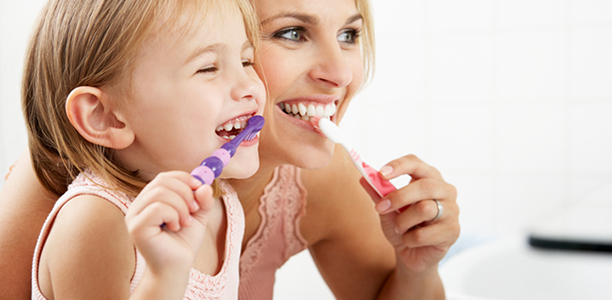Why is brushing teeth important?
Brushing teeth is the basis of good oral hygiene and contributes to overall health. The process of brushing removes bacteria that can cause tooth decay and gum infections if left in the mouth. It reduces the likelihood that your child will get dental cavities (holes in their teeth).
How often should kids brush their teeth?
Kids, just like adults, should brush their teeth twice a day, in the morning after breakfast and at night immediately before bed. Once they have reached 18 months of age, they should brush using fluoride toothpaste. Before 18 months of age, just use a toothbrush, without toothpaste. A proper brush should take about three minutes.
How parents can help kids
Parents can do various things to support their children’s teeth brushing at different ages. However no matter what age your child is, an important way to encourage children to adopt positive behaviours like twice daily brushing, is to model them yourself.
Babies will need parents and carers to brush their teeth for them, and it’s important to start as soon as their first tooth erupts (breaks through the gums). Don’t wait until they have a full set of teeth. To prepare your baby for brushing, begin wiping their gums with a soft cloth twice a day. When they get their first tooth, buy them a soft tooth brush with a small head of bristles.
When you start brushing their teeth, make it fun and send a message to your children that brushing teeth is not only important, it’s also enjoyable. Using the downloadable tooth brushing chart to track your child’s brushing habits, and reward them with a tick every time they brush their teeth, is a great way to make brushing an enjoyable, twice-daily routine.

Download the free tooth brushing chart.
Other great ways to make brushing more fun for toddlers and young kids, is to play a song they love while you are brushing their teeth, buy them a toothbrush or toothpaste with a book or television character they love on it, or use an egg timer to time their brushing.
Toddlers will also need you to brush their teeth for them, using a small, soft toothbrush. At this age, apply a pea-sized amount of fluoride toothpaste to the brush. Use a circular brushing motion to gently clean all surfaces of each of their teeth, and their gums. Make sure they do not swallow the toothpaste.
Your child will gradually develop the skills needed to brush their own teeth, however you’ll need to keep helping them until around 7-8 years of age. Even when they have the skills to brush their teeth properly, parents still play an important role in making sure they actually brush their teeth, by supervising every brush.
Should children floss?
Flossing is important for children too. You’ll also need to start using dental floss to clean between teeth, as soon as any two of your child’ teeth touch each other. You’ll be able to gradually reduce the amount of assistance you provide your child with flossing, as they develop the skills they need to do it themselves, at around ten years of age.
Tooth brushing chart
How to use the tooth brushing chart
Download the free Parenthub tooth brushing chart.
- Write your child’s name on the chart.
- Print and laminate the chart.
- Hang the tooth brushing chart on the wall, at your child’s eye level, so that they can see and reach it easily.
- Hang a washable felt tip pen (whiteboard marker) near the chart.
- Each time your child brushes their teeth, in the morning and at night, tick the space (or instruct them to do it themselves if they are old enough) corresponding to that day and time on the chart.
- Congratulate your child for brushing their teeth and getting rid of bacteria that might have caused holes in their teeth.
- At the end of each week, look at the chart with your child and count the number of times they cleaned their teeth. Congratulate them for brushing twice every day and getting a perfect score for tooth brushing. Wipe the chart clean so you can continue to complete it every week.
- If they complain about brushing their teeth (as energetic toddlers and older kids sometimes do), remind them that they need to brush or they won’t be able to get a perfect teeth brushing score this week.
Alternatives
If you don’t have a laminator, you can:
- Reprint the chart each week and the child can put a sticker on each time they brush their teeth, or just tick it off; or
- Place the chart in a frame which has a clear glass or plastic cover. Mark off each brushing with a washable pen and then at the end of the week, wipe clean the frame with a bit of diluted white vinegar in water and an old rag.
Educational benefits of using a tooth brushing chart
Self-care
Using the tooth brushing chart sends a message to your child that brushing teeth is important. Encouraging them to brush twice a day from a young age, is an important way to establish good dental hygiene practices for a lifetime.
Mathematical skills
Using the tooth brushing chart will help your child develop a range of mathematical skills. They’ll improve their ability to count, and other number skills like one to one correspondence. They will learn one to one correspondence when they count how many times this week they have brushed their teeth, and point at each of the tick boxes when they count. They increase their understanding of time and sequence concepts like day morning and night, as they follow and record their daily brushing routine.
They’ll also be becoming increasingly good at explaining how tooth brushing fits into other aspects of their daily routine like eating breakfast and going to bed. The tooth brushing chart allows your child to collect, analyse and interpret information about their tooth brushing behaviour. For example, they might interpret a score of 14/14 on the tooth brushing chart means they are a good tooth brusher and are protecting their teeth from bacteria. This ability to interpret information about themselves provides an important foundation for recording numerical information in more complex charts and tables, later in life. Help them develop these mathematical skills by asking them questions about the information they record in the tooth brushing chart.
Emotional development
Using the tooth brushing chart is also a great way to help your child develop positive emotional responses, which is an important part of every child’s social development. You may find you use it to curb negative emotions like tantrums they have because they don’t want to clean their teeth. Creating routines and letting your child know they have to be carried out every day, helps your child know what to expect and how to handle it emotionally. As your child grows older, you should notice that they are increasingly able to regulate their own emotions, and clean their teeth (or let you help them) without any tantrums. You should also notice your child showing pride in their daily and weekly tooth brushing accomplishments and their growing independence.
Fine motor skills
Placing a tick in the correct box of the tooth brushing chart will require your child to hold the pen to write, which is an important way to use and further develop the finger muscles or fine motor skills. They will need to use their arm in a different way compared to writing with a pencil and paper at a table, so they’ll be exercising slightly different muscles.
Early literacy skills
Even before they can read and write, children are developing literacy skills. Seeing printed text and information, like that on the tooth brushing chart, helps toddlers and early pre-schoolers develop understandings, for example, that printed words and pictures convey information, just like speaking.
Choose your free toothbrushing chart
- Toothbrushing chart: Monkey Graphic
- Toothbrushing chart: Squirrel Graphic
- Toothbrushing chart: Boy Graphic V1
- Toothbrushing chart: Boy Graphic V2
- Toothbrushing chart: Boy Graphic V3
- Toothbrushing chart: Girl Graphic V1
- Toothbrushing chart: Girl Graphic V2
- Toothbrushing chart: Girl Graphic V3
References
- Early Childhood Development Alignment Program. Milestones of child development- A guide to young children’s learning and development from birth to kindergarten. 2013. (cited 12 March 2017). Available from: (URL Link)
- Australian Dental Association. Your Dental Health- Babies. 2018. (cited 27 January 2018). Available from: (URL Link)
- Australian Dental Association. Your Dental Health- Toddlers. 2018. (cited 27 January 2018). Available from: (URL Link)
- Australian Dental Association. Your Dental Health- Kids. 2018. (cited 27 January 2018). Available from: (URL Link)
- Women’s and Children’s Health Network. Teeth- Open wide- Looking after your teeth. 2017. (cited 27 January 2018). Available from: (URL Link)
- Australian Government. Healthy Mouths, Healthy Lives: Australia’s National Oral Health Plan 2015-2024. (cited 27 January 2018). Available from: (URL Link)
- United States Department of Education. Fostering Healthy Social & Emotional Development in Young Children. 2017. (Cited 29 January 2017). Available from: (URL Link)



 (5 votes, average: 4.20 out of 5)
(5 votes, average: 4.20 out of 5) 






